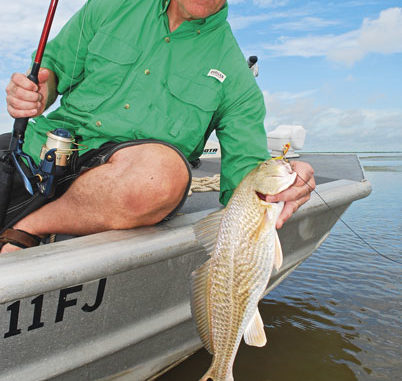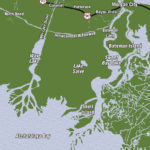
Fancy techniques aren’t necessary if you know where to fish at the mouth of the Atchafalaya River.
The Atchafalaya Delta has to be the foggiest place on earth, certainly in Louisiana. I was sitting in the dark at the Wax Lake Boat Landing at Calumet, waiting for the fog to lift for the run down to Wax Lake Delta to fish for redfish.
Although one of the men with me, Pat Attaway of Lafayette, had a route to the delta programmed into his GPS, running in both the dark and the fog is never fun.
So there we sat waiting for it to get light enough to pick our way down the channel. The second man of the pair, John Dupuis, retrieved an aluminum foil-wrapped object from a bag, unwrapped the foil and revealed three sticks of boudin. They were steaming slightly.
“I heated it before I left the house,” he explained in a Cajun accent as thick as molasses.
The rice and pork sausage was spicy and just perfect to brush away the dampness of the fog. I asked where he
bought it.
“Charlie T’s in Breaux Bridge,” he replied in a note in his voice that showed that he thought it incredible that I should even ask if there were another boudin maker in existence. “That’s the place to get boudin, eh?”
Attaway watched the fog and creeping light closely.
“We want to get down there early so that we can fish the falling tide,” he explained. “The tide will be out at noon.
“In our experience it is better to fish when it is falling and the drains are draining. When it is high, the fish are up in the grass.”
Redfish fishing on the Atchafalaya River deltas, both the main delta and the Wax Lake delta, is much like the duck hunting for which the deltas are so famous. Only for ducks, it’s in reverse; so many hunters plan their hunts around a
rising tide.
As soon as the fog began to lift, Attaway cranked the big outboard and turned the nose of the Hanko south for the 11-mile run to the delta.
Once on the delta, both men pointed out flocks of teal
skittishly wheeling over the marsh like squadrons of fighter jets, as well as a few much larger and more sedate mottled ducks.
Wax Lake Outlet breaks into three main passes on the delta itself. Campground Pass branches off to the west first. Farther south lie East Pass, Greg Pass and Main Pass. Attaway shot the boat down Greg Pass, the center one of the three.
“This is the area that we duck hunt in and know,” he said. “We have fished Main Pass too and there are redfish all over the delta, but we really don’t have to fish anywhere else.”
He seemed confident.
Attaway stopped the boat when all visible signs of land had disappeared, with only grass beds to mark the submerged banks of the channel. After he dropped the trolling motor into position, Dupuis muttered from the back of the boat, “Shame on them redfish.”
Guiding the boat upstream within casting distance of the grass beds, the two men began
working the edges of the vegetation with their baits. Their rigs were simple. Attaway used a 3/8-ounce jig head set about 18 inches under a weighted popping cork. Like Dupuis, he impaled a whole shrimp tail on the hook.
Dupuis’ rig seemed to be a Rube Goldberg version of Attaway’s. Beneath, an unweighted popping cork, he tied a 16-inch wire leader and then an old-style shad rig head that he cut off a
store-bought tandem redfish rig. To add enough weight for long-distance casting, he twisted on
a rubber core lead sinker between the cork and
the leader.
The shad rig head was yellow, what Dupuis
prefers and refers to as “Old Yella.” I asked him about what appeared to be the cumbersome
construction of his rig.
“This is how I learned years ago, and it works,” he said. “Why change what works?”
I chuckled smugly, but Attaway, who is now an accomplished trout fisherman, backed up Dupuis.
“I learned everything from John,” he said. “Fishing redfish on the delta was my introduction to saltwater fishing a dozen years ago.”
Dupuis flashed a satisfied cheese-eating grin at me.
The falling tide combined with the river’s flow down the pass gave the 24-volt trolling motor a workout as the men probed the margins of the grass beds with their baits.
While some of their casts seemed somewhat random, including a few into deep water well away from the grass beds, most of them were
targeted toward something noticeably different than the ordinary. A
riffle of water running through a gap in the plants indicated a slightly deeper cut across the sandbar and drew at least one cast.
In fact, any current ripple drew their attention. So did differences in
the grass beds.
“I look for pockets on the edge of the grass with current running through them,” tutored Dupuis. “That’s where redfish want to be.”
Points of grass that extended farther into the pass than the rest of the plant bed also received attention. And in fact, from one of those was where Attaway hauled in the first redfish of the day, one that just made the 16-inch cut.
The early fishing was slow, although the morning was beautiful. The rising sun chiseled the men’s features against the blue sky like Mount Rushmore. Waterfowl, mostly teal, were in regular sight and gunshots peppered the air. It was the last day of teal season.
Attaway expressed no worry.
“Conditions are good,” he said. “The river is under 5 feet on the Butte LaRose gauge. Fishing is really good in October, but any time the river is under 5 feet it is good for redfish on the delta. We routinely catch them up to 5 pounds, but only a few are over 21 inches.”
The men picked up small redfish sporadically, along with some gafftop catfish, but they were unsatisfied. Lots of fish were moving in the
interiors of the grass beds, but they speculated that the tide wasn’t low enough yet to push the fish to the edges.
After a conference, they decided to move to another area, but before they did, they wanted to stop in Main Pass to check a run-out that drains a high part of the marsh between Main and Greg passes.
As soon as the boat neared the drain, it was
obvious that the water was barreling out of the small cut. A plume of clearer water extended well out into the turbid river waters of the pass.
It was a beautiful spot. The freshwater marsh vegetation framing the runout, willows, duck
potatoes, elephant ears, bulrushes and cattails, were lush and aesthetically pleasing.
The fish were there too. Dupuis immediately hooked up with a pan-sized flounder. Attaway replied with a keeper redfish. Both species regularly came over the boat’s gunnels with redfish outnumbering flounder by two
to one.
Halfway into their redfish limit, Attaway took off his popping cork to try to catch more flounder, one of his favorite tablefish. Dupuis followed, but instead of a flounder, he nailed the biggest fish of the day, a solid 27-inch redfish.
Almost too quickly it was over. It was just after 10 a.m.; five
redfish per man isn’t a lot of fish when they are biting. A few were 16-inchers, but many were 18 to 21 inches — good fighting fish, good table fish.
They decided to keep fishing, planning to tag and release the redfish and perhaps pick up a couple more flounder. But the edge was off of their intensity.
I asked them about modern duck hunting on the delta.
“It’s a shadow of what it was years ago,” Attaway answered. “In its heyday, you could point anywhere in the sky on an
average day, all day, you could point anywhere and be pointing at ducks. Now, some days you don’t even see a duck.”
“I started hunting here with Pat in 1998,” said Dupuis. “I loved it. Everywhere you looked you saw ducks. You saw ducks at any moment the whole day. Now … .
“The delta is still beautiful though — all the greenery and all the birds — gros becs and bec croche. They say that those are good to eat.”
He grinned at me mischievously.




